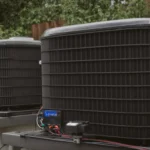Carbon monoxide (CO) gas is colorless, odorless, and potentially deadly. It is produced by the incomplete combustion of fuels, such as gasoline, propane, coal, wood, and other materials. Carbon monoxide gas can accumulate in enclosed or poorly ventilated spaces, leading to suffocation.
Symptoms of carbon monoxide poisoning include headache, nausea, vomiting, dizziness, and confusion. If left untreated, carbon monoxide poisoning can lead to brain damage, heart attack, and death. Carbon monoxide gas is especially dangerous for pregnant women, young children, and people with heart or respiratory conditions.
For these reasons, it’s critical to have carbon monoxide detectors in your home. However, you may be wondering where to place carbon monoxide detectors. In this blog post, we’ll cover all of the essential locations throughout your home that should have a carbon monoxide detector.
Carbon Monoxide Detectors
A carbon monoxide detector is an electronic device that senses the presence of carbon monoxide and warns you of an unsafe level. There are two types of carbon monoxide detectors: battery-operated and plug-in. Battery-operated detectors are the most common type. You should test your carbon monoxide detectors at least once a month. Test the detectors by depressing the test button. The alarm should sound, and the LED should light up.
In the Hallway near the Bedrooms

Carbon monoxide detectors should be placed in the hallway near the bedrooms. There are a few reasons why carbon monoxide detectors should be placed in the hallway near the bedrooms. If a carbon monoxide detector is placed in the hallway, you will be more likely to hear it if it goes off, and you can investigate the cause of the alarm.
Another reason to place carbon monoxide detectors near the bedrooms is that people generally spend the most time in their bedrooms. If there is a carbon monoxide leak in your home, you will be more likely to be affected by it if the leak is in your bedroom than if it is in another part of your home.
Out of the Reach of Children and Pets

Carbon monoxide detectors should be placed in an area where they will be out of the reach of children and pets. It is important to keep these devices out of the reach of small children and animals because they may try to play with or eat them. Additionally, if a carbon monoxide detector is placed in an area where it is easily accessible, it will be more likely to be activated accidentally, which could result in a false alarm.
In Close Proximity to Gas Appliances and Fuel-Burning Equipment

Carbon monoxide detectors should be placed in close proximity to gas appliances in order to ensure that they are able to detect any potential carbon monoxide leaks. Carbon monoxide detectors should be placed as close as possible to heating appliances and fuel-burning equipment. This includes furnaces, fireplaces, wood-burning stoves, and space heaters.
On Every Level of Your Home

It’s also important to install CO detectors on every level of your home, including the basement and in any bedrooms. If you have a large home, installing detectors in separate areas might be necessary to ensure adequate protection. Furthermore, you should have a CO detector near the water heater as they can produce high levels of CO as well.
Protecting Your Family from CO Poisoning
Now that you know where to install CO detectors, you can start protecting your family from CO poisoning. CO detectors are relatively inexpensive and can provide you and your family with added peace of mind. If you have any questions about installing or using a CO detector, please do not hesitate to contact a licensed professional.












